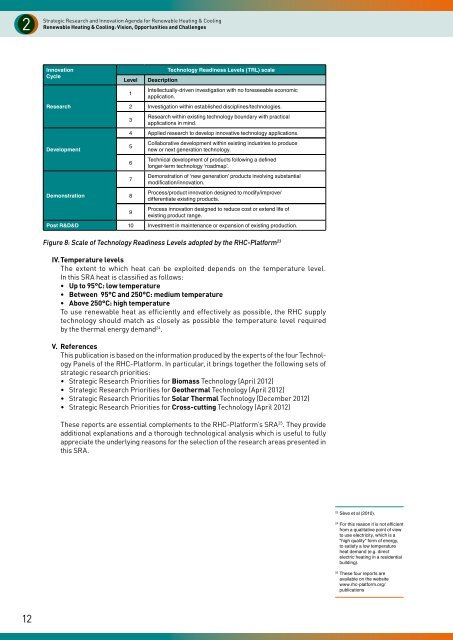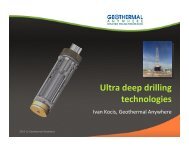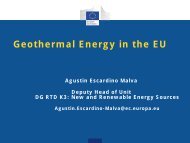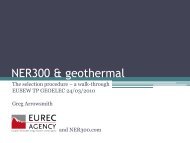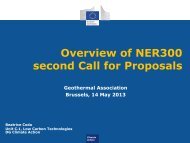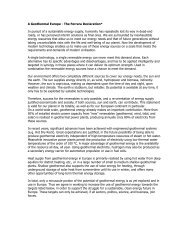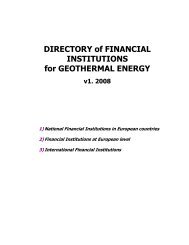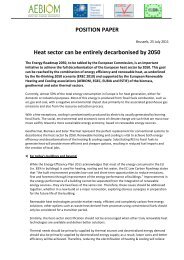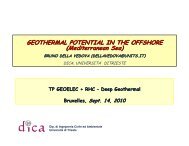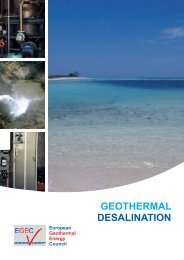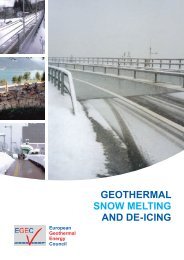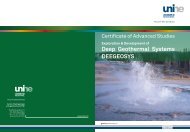Strategic Research and Innovation Agenda for Renewable ... - EGEC
Strategic Research and Innovation Agenda for Renewable ... - EGEC
Strategic Research and Innovation Agenda for Renewable ... - EGEC
Create successful ePaper yourself
Turn your PDF publications into a flip-book with our unique Google optimized e-Paper software.
2<strong>Strategic</strong><strong>Research</strong> <strong>and</strong> <strong>Innovation</strong> <strong>Agenda</strong> <strong>for</strong> <strong>Renewable</strong> Heating & Cooling<strong>Renewable</strong> Heating & Cooling: Vision, Opportunities <strong>and</strong> Challenges<strong>Innovation</strong>Cycle<strong>Research</strong>DevelopmentDemonstrationLevel1DescriptionTechnology Readiness Levels (TRL) scaleIntellectually-driven investigation with no <strong>for</strong>eseeable economicapplication.2 Investigation within established disciplines/technologies.3<strong>Research</strong> within existing technology boundary with practicalapplications in mind.4 Applied research to develop innovative technology applications.56789Collaborative development within existing industries to producenew or next generation technology.Technical development of products following a definedlonger-term technology ‘roadmap’.Demonstration of ‘new generation’ products involving substantialmodification/innovation.Process/product innovation designed to modify/improve/differentiate existing products.Process innovation designed to reduce cost or extend life ofexisting product range.Post R&D&D 10 Investment in maintenance or expansion of existing production.Figure 8: Scale of Technology Readiness Levels adopted by the RHC-Plat<strong>for</strong>m 23IV. Temperature levelsThe extent to which heat can be exploited depends on the temperature level.In this SRA heat is classified as follows:• Up to 95°C: low temperature• Between 95°C <strong>and</strong> 250°C: medium temperature• Above 250°C: high temperatureTo use renewable heat as efficiently <strong>and</strong> effectively as possible, the RHC supplytechnology should match as closely as possible the temperature level requiredby the thermal energy dem<strong>and</strong> 24 .V. ReferencesThis publication is based on the in<strong>for</strong>mation produced by the experts of the four TechnologyPanels of the RHC-Plat<strong>for</strong>m. In particular, it brings together the following sets ofstrategic research priorities:• <strong>Strategic</strong> <strong>Research</strong> Priorities <strong>for</strong> Biomass Technology (April 2012)• <strong>Strategic</strong> <strong>Research</strong> Priorities <strong>for</strong> Geothermal Technology (April 2012)• <strong>Strategic</strong> <strong>Research</strong> Priorities <strong>for</strong> Solar Thermal Technology (December 2012)• <strong>Strategic</strong> <strong>Research</strong> Priorities <strong>for</strong> Cross-cutting Technology (April 2012)These reports are essential complements to the RHC-Plat<strong>for</strong>m’s SRA 25 . They provideadditional explanations <strong>and</strong> a thorough technological analysis which is useful to fullyappreciate the underlying reasons <strong>for</strong> the selection of the research areas presented inthis SRA.23Sève et al (2010).24For this reason it is not efficientfrom a qualitative point of viewto use electricity, which is a“high quality” <strong>for</strong>m of energy,to satisfy a low temperatureheat dem<strong>and</strong> (e.g. directelectric heating in a residentialbuilding).25These four reports areavailable on the websitewww.rhc-plat<strong>for</strong>m.org/publications12


